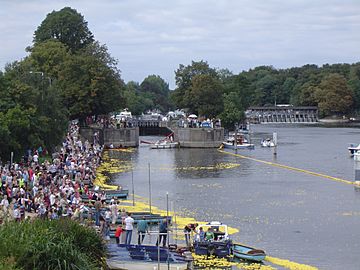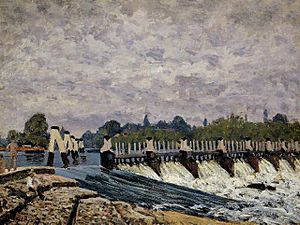Molesey Lock facts for kids

The lock after the release of 160,000 Rubber ducks at the start of the Great British Duck Race in September 2007
|
|
| Waterway | River Thames |
|---|---|
| County | Surrey |
| Maintained by | Environment Agency |
| Operation | Hydraulic |
| First built | 1815 |
| Latest built | 1906 |
| Length | 81.78 m (268 ft 4 in) |
| Width | 7.56 m (24 ft 10 in) |
| Fall | 1.85 m (6 ft 1 in) |
| Above sea level | 20 ft (6.1 m) |
| Distance to Teddington Lock |
4.8 miles |
| Coordinates | 51°24′17″N 0°20′45″W / 51.40472°N 0.34583°W |
| Power is available out of hours | |
Molesey Lock is a special gate system on the River Thames in England. It's located in East Molesey, Surrey, on the right side of the river. A lock helps boats move between different water levels.
The City of London Corporation first built this lock in 1815. It was later rebuilt in 1906 by the Thames Conservancy. Molesey Lock is the second longest lock on the River Thames, measuring about 81.78 meters (268 feet) long.
Near the lock, you can find places to rent small boats like skiffs, paddleboards, and kayaks. There's also a pier for tour boats and kiosks selling ice cream and drinks. Just upstream from the lock, there's a small island called Ash Island.
Molesey Lock is very close to the famous Hampton Court Palace. You can even see the palace walls from the lock, through the arches of Hampton Court Bridge.
Contents
Fun on the Water at Molesey Lock
Molesey Lock has always been a popular spot for people who love boats and the river. In the Victorian and Edwardian times (the late 1800s and early 1900s), many visitors came to watch the boats and enjoy the scenery.
Today, the area around the lock is still busy, especially for nine months of the year. Boat rental companies and ice cream sellers attract many visitors. It's a great place to enjoy a day out by the river.
History of Molesey Lock
People first suggested building a lock here in 1802 because the water upstream was too shallow. However, nothing happened until 1809 when the idea was brought up again.
In 1812, a law was passed to allow the lock to be built. Construction started in 1814, and Molesey Lock opened in 1815. The first lock keeper, who looked after the lock, sadly died in a horse race. His replacement was later fired for stealing from boats.
Over the years, changes were made to the lock. In 1853, updates helped with lower water levels. In 1864, special "Fish ladders" were added to the weir (a small dam) to help fish move upstream. The entire lock was rebuilt in 1906 to make it more modern.
On a small island near the lock, there is a plaque. It remembers Michael J Bulleid, who worked hard to help salmon swim up the river.
Getting to Molesey Lock
Molesey Lock is about 220 meters (720 feet) upstream from Hampton Court Bridge. It's on the right bank of the river, which is the south side. You can easily reach it from Hurst Road/Riverbank (A3050). There are pavements and a sloped path leading to the lock. It's also only about 330 meters (1,080 feet) from Hampton Court railway station.
The River Stretch Above the Lock
After the lock, you'll find Tagg's Island. This island is home to many houseboats, some of which are three stories tall! On the Surrey side of the river, there's a tall metal sculpture called the "Eights Tree" outside Molesey Boat Club.
The opposite bank, on the London side, is sometimes called the Hampton Riviera. Here you can see interesting buildings like the Swiss Cottage and the Astoria Houseboat. Further along is Garrick's Ait, another island with homes. A ferry, called the Hampton-Molesey Hurst Ferry, runs in the summer between Hampton and Moulsey Hurst park.
Islands and Landmarks Upstream
As you go further upstream from Molesey Lock, you'll find more islands and interesting spots:
- Left bank (Hampton side):
- Benn's Island is one of the smallest islands on the Thames. It has the Hampton Sailing Club building.
- Platt's Eyot is an island where Motor Torpedo Boats were built during World War II.
- Near Platt's Eyot, there are water treatment works and reservoirs.
- Grand Junction Isle has a few chalets and a footbridge.
- Sunbury Court Island is another residential island.
- Rivermead Island is a large public park.
- The area near Sunbury Weir is popular for kayaking.
- Wheatley's Ait is a large island formed by the River Ash joining the Thames.
- Right bank (Molesey side):
- Moulsey Hurst is a large open area with historical markers.
- Beyond this, you'll see the Molesey Reservoirs behind the walking path to Walton-on-Thames.
Sports and Events on the River
This part of the River Thames is a hub for water sports! It's home to two sailing clubs and three rowing clubs. Two of the rowing clubs belong to large independent schools.
- The Molesey Regatta is a big rowing event that takes place in July near Platts Eyot.
- The Sunbury Amateur Regatta is held in August near Rivermead Island.
Sports Clubs on the Reach
- Molesey Boat Club

- Hampton School Boat Club (shares Millennium Boathouse with LEH School)

- Sunbury Skiff and Punting Club

- Lady Eleanor Holles School Boat Club (shares Millennium Boathouse with Hampton School)
- Hampton Sailing Club
- Aquarius Sailing Club
- Hampton Canoe Club
Waterworks and Reservoirs
You can see large reservoirs on both sides of the river above Sunbury Lock. These were built after a law in 1852 made it illegal to take drinking water for London from the tidal Thames (the part affected by tides) below Teddington Lock. This was because there was too much sewage in the river.
The Hampton Waterworks were built on the northern bank in the 1850s. The reservoirs at Molesey, on the southern bank, were built later, starting in 1872.
Thames Path
The Thames Path is a long-distance walking trail that follows the River Thames. In this area, the path stays on the Surrey bank (the right bank) all the way to Sunbury Lock. You might even spot a large tank trap from World War II near the reservoirs on the right bank.
Molesey Lock in Books and TV

- The famous writer Jerome K. Jerome wrote about the lock in the 1880s. He described how busy and colourful it was with boats and people.
- Molesey Lock was also shown in an episode of the gardening TV show Ground Force.


